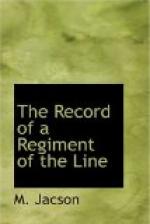On the evening of December 18th the Regiment gave over the good works they had completed on Devon Post and Cemetery Hill to the Liverpool Regiment, and moved into the latter’s camp at Tunnel Hill, or, as it was otherwise known, Railway Cutting Camp.
* * * * *
Helpmakaar Hill, on account of being so exposed, had, at the commencement of the siege, been considered indefensible and untenable.
Under the vigorous superintendence of Colonel Knox, the commandant of the section who planned the defences, the works on this hill had by now been almost completed by the officers and men of the Battalion.
The defences were as complete as possible—flanking works, covered ways, splinter and shell-proof covers were dug or erected, and the main trenches had been turned into defensible barracks with head cover to keep off the rain.
It was possible to proceed from the reserve under Cemetery Hill up to and round the front and main works, and round the other side of the hill back to the reserve again, without once coming into view from the Boer positions on Gun Hill, Bulwana, or elsewhere, a six-feet covering wall having been built for this purpose. It was thus possible to send reinforcements to any part of the works without exposure to fire or view.
During the siege this post was never attacked or seriously threatened.
The Regiment, being now in the general reserve, was ordered to be ready to jump into mule wagons, and be carted at a gallop to any place where they might be required, at any moment, and on the 20th the manoeuvre was put into execution.
It was not altogether a success.
At dusk the Regiment proceeded to the railway station and the men were duly loaded up in the wagons. A start was then made, but as the second wagon nearly took the whole station with it in its endeavours to negotiate the first corner of the galvanized iron goods shed, no great speed was effected, for this wagon and the demolished corner of the shed blocked all further egress from the station till the road was cleared. Shortly afterwards the wagons, at last let loose, came into contact with the two city filth carts, the “Powerful” and “Terrible,” which were parading about the streets on their own. These exceedingly powerful ironclads completed the defeat of the mule wagons, upset finally their order of going, and the retirement was effected in detachments. The manoeuvre was never repeated.
Wonderful tales and reports were continually being circulated from day to day. On one day there would perhaps be no news of any value, followed on the next day by the most woeful tidings; but on the third day, as if ashamed of themselves for furnishing such bad news the previous day, the tale-bearers would turn the winter of its discontent into the most glorious summer, by sending forth to the garrison shaves bubbling over with pleasing items.
On the evening of the 21st a heliograph message was received from the 2nd Battalion, which was with Sir Redvers Buller, stating that at the Colenso fight on the 15th December Colonel Bullock, Major Walter, and Lieutenant Smyth-Osbourne had been taken prisoners, and Captains Goodwyn, Vigors, and Radcliffe and Lieutenants Gardiner and Storey wounded.




